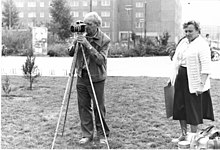Walter Danz
Walter Danz (born April 21, 1904 in Halle (Saale) ; † November 2, 1986 there ) was a German photographer in Halle.
Life
Danz first completed an apprenticeship as a commercial clerk, where he worked for a while. He initially dealt with environmental studies and landscape photographs . Like Lyonel Feininger at the same time , he was inspired by the buildings in his hometown. With the Great Depression , the new way of seeing appeared in photography . Hans Finsler taught art history at Burg Giebichenstein and from 1926 supervised the first German photography class there. Under his influence, Danz switched from a commercial life to the professional life of a photo reporter for the “Illustrierte Hallische Nachrichten” in 1932 . At that time the unemployment rate had risen to 45% and Halle - already the “red heart of Central Germany” during the imperial era - had become a focal point of social hardship and poverty. In his photographs Danz reflected the increasing dissatisfaction and politicization. As a press photographer , he could no longer make a living from 1938. With Heinrich Ziegler, one of the first Finsler students, he opened a photo shop on Grosse Steinstrasse. A little later he had to leave it to him. He was drafted into the army (Wehrmacht) and later became a prisoner of war . Ziegler dissolved the company. In the post-war period , Danz devoted himself to architectural and non-life photography . Among other things , he documented arts and crafts for the Burg Giebichenstein University of Art . In 1950 he was awarded the title of master photographer. The Association of Visual Artists of the GDR took him in 1952 as the first photographer. Regarding Danz's pictures from the 1930s, Maria Meinel says :
“In addition to the unpretentious approach to the subject and the simplicity of the depiction, the images impress with their clear, conscious design. Clear diagonals determine the picture surface, suggest movement and emphasize the ephemeral nature of the captured moment. But it is a quiet, reverent and extremely cautious creation that is more like picky seeing than intervening in the essence of the subject. And then there is the slowness peculiar to the images, which seems to withstand the mobilization, acceleration and mechanization of those years, even to look towards it and which invites the viewer to linger and reflect. "
Awards
In 1984 he was awarded the Handel Prize of the Halle district .
estate
Christine Lundershausen, Danz's long-time partner, took care of the photographic estate. Over 2000 works went to Giebichenstein Castle, a large part of the negatives to the Prussian Cultural Heritage Foundation . Some of the works are now in the Halle city archive and a few hundred works are in the photography collection of the Moritzburg Foundation .
Web links
- Literature by and about Walter Danz in the catalog of the German National Library
Individual evidence
- ↑ Life data according to information from the Halle city archive
- ^ Maria Meinel: Walter Danz - Photography, photos from 1936 to 1939 (2011)
- ↑ Christoph Rink: Chronology of the Handel price . In: Announcements of the Friends and Supporters of the Handel House in Halle eV 1/2012, pp. 20–25, here: p. 25.
- ↑ Photo collection from the custodian and archive Burg Giebichenstein Halle (fotoerbe.de)
| personal data | |
|---|---|
| SURNAME | Danz, Walter |
| BRIEF DESCRIPTION | German photographer |
| DATE OF BIRTH | April 21, 1904 |
| PLACE OF BIRTH | Halle (Saale) |
| DATE OF DEATH | November 2nd 1986 |
| Place of death | Halle (Saale) |
